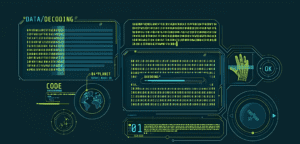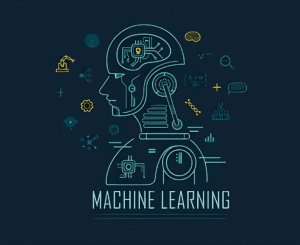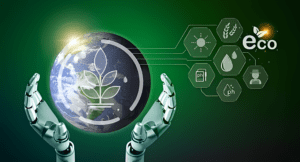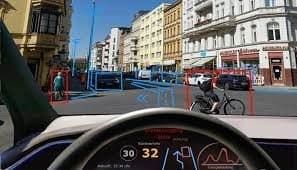I. Introduction
Before discussing how IoT (Internet of Things) and AI (Artificial Intelligence) are related, we need to know what IoT and AI are. So, let’s see that first.
Definition of IoT
“The Internet of Things IoT is a network of interconnected physical devices or “things” equipped with sensors, software, and other technologies that collect and exchange data via the internet.” These devices can range from commonplace goods like domestic appliances, wearable devices, and industrial gear to smart city infrastructure and other technologies.
In a nutshell, IoTentails connecting devices to the internet or one another to communicate and share data. The goal is to build a network that allows devices to collect and exchange data, resulting in enhanced automation, efficiency, and chances for data-driven insights.
Definition of AI
“AI is the simulation of human intelligence in computers programmed to think, learn, and execute activities that normally require human intelligence.” These tasks include problem-solving, interpreting natural language, seeing patterns, learning from experience, and adjusting to changing circumstances.
Why their integration is important?
Integrating AI (Artificial Intelligence) and IoT (Internet of Things) is critical because it establishes a synergistic interaction between smart devices and intelligent analytics. This combination:
- Improves Decision-Making: AI analyzes massive volumes of data generated by IoT devices to provide real-time insights and educated decision-making.
- Improves efficiency: AI-driven analytics optimize IoT device operation, streamlining procedures and enhancing overall system efficiency.
- Enables Predictive Capabilities: When IoT-generated data is combined with AI analytics, predictive modeling allows businesses to foresee trends, difficulties, and opportunities.
- Enables Automation: AI and IoT integration enables automation by allowing devices to learn from data, adapt to changing situations, and complete activities without explicit programming.
- Promotes Personalization: The integration allows for tailored user experiences by adapting services to individual preferences, resulting in higher customer satisfaction.
- Increases Security Measures: AI improves IoT system security by detecting anomalies, recognizing potential cyber-attacks, and executing preventative security measures.
- Stimulates Innovation: The combination of AI and IoT promotes innovation by establishing intelligent ecosystems that constantly learn, adapt, and change in response to changing situations.
The relevance stems from AI and IoT’s combined ability to transform data into actionable insights, automate processes, and drive intelligent decision-making across multiple domains.

How they create intelligent ecosystems?
By integrating IoT data creation and connectivity of IoT with the analytical and decision-making capabilities, IoT and AI build intelligent ecosystems.IoT devices create data, which AI algorithms evaluate in real-time, allowing adaptive automation, predictive analytics, personalized services, and efficient resource management inside networked systems. The convergence of IoT and AI promotes continuous Learning, resulting in intelligent and responsive ecosystems across multiple domains.
II. Understanding IoT: Building the Foundation
The term “Internet of Things” IoT denotes a network comprising interconnected physical objects or “things” that are equipped with software, sensors, and other technological components to facilitate the collection and exchange of data via the internet. The array of devices encompasses not only peripheral devices and commonplace appliances but also industrial machinery and smart city infrastructure. The principal objective of IoT is to facilitate the communication and information exchange among these devices, resulting in enhanced operational effectiveness, automated processes, and novel opportunities for insights derived from data.
Here is a video
Essential IoT components
Essential IoT components includes:
- Devices and Things: Physical entities or objects furnished with connectivity functionalities, sensors, and actuators, allowing for data exchange and interaction with the surrounding environment.
- Connectivity: In an IoT ecosystem, the devices are interconnected via local networks or the internet, enabling them to exchange information and communicate with centralized systems.
- Data Processing: The Internet of Things produces an enormous quantity of data. Cloud computing and peripheral computing technologies are frequently employed to analyze and process this data to extract significant insights.
- Implementations: The data acquired by IoT devices has the potential to be applied in a multitude of ways, including enhancing user experiences in smart homes and increasing the efficacy of industrial processes.
Considering the interconnectivity of Internet of Things (IoT) devices, security emerges as an imperative consideration. It is crucial to protect against unauthorized access and maintain the confidentiality and integrity of data.
IoT Devices and Their Applications
- Smart Thermostats:
- Adjust the temperature of the home based on user preferences and environmental factors.
- Nest Learning Thermostat, for example, learns user habits and optimizes heating and cooling.
- Smart Watches:
- Monitoring health measures such as heart rate, sleep patterns, and physical activity.
- Fitbit, for example, tracks fitness activity and delivers health data.
- Connected Cars:
- Data collection on vehicle performance, navigation, and driver behavior.
- Tesla vehicles capture real-time data to provide over-the-air updates and autonomous driving features.
- Smart Refrigerator:
- Managing grocery inventory, expiration dates, and recipe suggestions.
- Samsung’s Family Hub users can view and manage fridge contents via a mobile app.
- Industrial Sensors:
- Monitor machinery, detect abnormalities, and ensure optimal performance.
- IoT sensors track equipment conditions for predictive maintenance in manufacturing plants.
- Smart Lighting Systems:
- Based on user preferences, control lighting intensity, color, and scheduling.
- Philips Hue allows users to control lights and create dynamic lighting scenarios remotely.
- Smart Agriculture:
- Monitoring soil moisture, temperature, and crop health for precision farming.
- Soil sensors aid in agricultural irrigation optimization for water efficiency.
- Connected Security Cameras:
- Remote monitoring, motion detection, and real-time alerts are all available.
- The Ring Video Doorbell app allows users to watch and speak with visitors.

III. Decoding AI: The Intelligence Behind the Scenes
Artificial intelligence (AI) is the development of computer systems capable of doing tasks that need human intelligence. These tasks include Learning, reasoning, problem-solving, natural language comprehension, and perception of the environment. AI seeks to develop machines that can simulate cognitive functions associated with human intelligence, allowing them to adapt, learn from experience, and execute tasks independently.
Types of AI systems
AI systems are classified into two types:
Small AI (Weak AI):
Restricted AI is focused on a restricted range of functions and is designed to execute a single task. Virtual personal assistants, picture and speech recognition, and recommendation systems are a few examples.
General AI (Powerful AI):
General AI refers to a system that, like human intelligence, can understand, learn, and apply intelligence across various tasks. True general AI is a continuous goal that is still being researched and developed.
AI is used in various areas, including healthcare, banking, education, and others, to improve efficiency, automation, and decision-making processes.

Principles of Artificial Intelligence (AI)
The AI principles, which frequently incorporate ethical considerations, transparency, and responsible use, vary, but some significant principles are as follows:
- Fairness:
- Ensure that all individuals and groups are treated fairly and without bias or discrimination by AI systems.
- Assess and minimize bias in training data, algorithms, and decision-making processes regularly.
- Transparency:
- Strive for transparency and clarity in AI systems so that users and stakeholders may comprehend their operations and decision-making processes.
- Explain AI decisions and make decision-making processes accessible and interpretable.
- Accountability:
- Hold individuals and organizations accountable for AI system design, development, and deployment, assuring accountability for their activities.
- Create clear lines of ownership and accountability throughout the lifecycle of the AI system.
- Privacy:
- Protect people’s privacy by safeguarding their data and ensuring that AI systems handle information responsibly.
- Follow privacy laws, anonymize data whenever possible, and prioritize user consent in data processing.
- Robustness and Reliability:
- Create AI systems resistant to errors, uncertainties, and adversarial attacks, resulting in consistent performance.
- Thoroughly test AI models in various settings, account for uncertainties, and implement safeguards to prevent probable failures.
- Safety:
- Prioritize user and broader environment safety in developing and deploying AI systems.
- To reduce potential harm, incorporate safety measures, conduct risk assessments, and design AI systems with fail-safes.
- Inclusivity:
- Ensure that AI technologies benefit and reflect diverse individuals and cultures without bias or exclusion.
- In the development process, consider varied perspectives and actively seek inclusion in datasets and apps.
These principles are a foundation for responsible AI technology development and deployment, directing ethical considerations, user trust, and good societal effect. They are frequently developing as the area of AI advances and new difficulties emerge.
Machine learning
Definition:
Machine Learning is a subset of AI that entails the creation of algorithms and models that allow computers to learn from data. The core concept is to allow machines to improve their performance on a certain activity over time without having to be explicitly programmed.

Key Concepts:
- Training Data: Machine learning algorithms learn from examples or training data, which is made up of input-output pairs.
- Learning Patterns: The algorithm discovers patterns, correlations, and trends in data.
- Model Construction: The learned patterns are contained in a model that may make predictions or judgments based on fresh, previously unknown data.
- Iterative Process: To increase performance, ML models frequently go through an iterative process of training, evaluation, and refining.
Types Of Machine Learning:
- Supervised Learning: The algorithm is trained on a labeled dataset, where the input data is coupled with appropriate output labels.
- Unsupervised Learning: The algorithm discovers hidden structures by exploring patterns and relationships in unlabeled data.
- Reinforcement Learning: The algorithm learns by interacting with its surroundings and feedback in the form of rewards or punishments.
Machine Learning Applications:
- Recognition of images and speech
- Natural Language Processing
- Analytics Predictive
- System of Recommendation
- Detection of Fraud
Deep learning
Definition:
Deep Learning is a specialized and sophisticated subset of Machine Learning that uses multiple-layer neural networks (deep neural networks). It is based on the structure and function of the human brain and allows systems to learn hierarchical data representations.
Key Concepts:
- Neural Networks: Deep Learning is based on neural networks with numerous levels, including an input layer, hidden layers, and an output layer.
- Feature Learning: Deep Learning learns hierarchical features and representations from raw data automatically.
- Complex Structures: Because Deep Learning models can capture deep patterns and relationships, they are well suited for complex jobs.
- Deep Neural Architectures: Convolutional Neural Networks (CNNs) for image processing and Recurrent Neural Networks (RNNs) for sequential data are two examples.
Deep Learning Applications:
- Object and Image Recognition
- Recognition of Speech
- Natural Language Processing (NLP)
- Self-driving cars
- Generative Models (for example, Generative Adversarial Networks – GANs)
Key Benefits:
- Feature Abstraction: Deep Learning learns hierarchical features automatically, eliminating the need for manual feature engineering.
- High Accuracy: With enough data and processing resources, Deep Learning models can attain cutting-edge performance.
In conclusion, Machine Learning refers to a broader collection of methods that allow computers to learn patterns from data, whereas Deep Learning is a subset of ML that focuses on neural networks with multiple layers, allowing for more sophisticated representations and automatic feature learning. Deep Learning has demonstrated exceptional performance in a wide range of applications, particularly those requiring huge and complicated datasets.

Role of AI in data analysis and decision-making
AI in Data Analysis:
Artificial intelligence in data analysis automates the detection of patterns, trends, and anomalies in huge datasets. It enables predictive analytics, automates data cleaning processes, and uses natural language processing (NLP) for unstructured data analysis, resulting in more efficient and thorough insights.
AI’s Role in Decision-Making:
By offering data-driven insights and suggestions, AI empowers decision-makers. By continuously learning from new data, it promotes tailored suggestions, automates routine judgments, and supports adaptive decision-making. AI improves the effectiveness and efficiency of decision-making processes by providing real-time decision support, scenario analysis, and resource optimization.
Here is a video
IV. The Interplay: How IoT and AI Collaborate
The interconnected link between IoT (Internet of Things) and AI (Artificial Intelligence) is distinguished by a synergistic alliance that expands the capabilities of each technology. Here’s a quick rundown:
- Data Generation and Collection:
Internet of Things: generate massive volumes of data via networked devices outfitted with sensors and actuators.
AI: Analyzes, recognizes patterns, and derives meaningful insights from this data.
- Intelligent Processing:
Internet of Things: Gathers and transmits real-time data from the physical environment.
AI: Intelligently processes and interprets this data, enabling informed decision-making.
- Adaptive Systems:
Internet of Things: Provides information on changing environmental conditions, user behaviors, and device statuses.
AI: Learns from the continual flow of IoT data to adapt to dynamic conditions, allowing systems to respond intelligently.
- Predictive Capabilities:
Internet of Things: Monitors and collects historical and real-time data.
AI: Uses predictive analytics to forecast future trends, behaviors, or maintenance requirements using IoT data.
- Automation and Autonomy:
Internet of Things: Creates networks of interconnected devices capable of performing automated operations.
AI: Improves automation by enabling intelligent decision-making, allowing devices to function autonomously.
- Optimized Resource Management:
Internet of Things: Collects data on resource use and usage patterns.
AI: This data is analyzed to improve resource allocation, boosting Efficiency and Sustainability.
- Real-time Decision-Making:
Internet of Things: Provides real-time data streams from sensors and devices.
AI: Quickly processes this data, allowing for real-time decision-making in reaction to changing conditions.
- Personalization:
IoT: Gathers information about user preferences and habits.
AI: Uses this data to provide personalized experiences like suggestions or adaptive smart home settings.
- Security and Anomaly Detection:
IoT: Monitors network and device activity for potential security risks.
AI: Machine learning algorithms are used to discover abnormalities and patterns suggestive of security breaches, hence improving overall Cybersecurity.
IoT and AI are inextricably linked, with IoT serving as the data source that powers AI’s intelligent decision-making and adaptive capabilities. This interaction improves efficiency, responsiveness, and innovation in various applications and sectors.
Examples of AI enhancing IoT capabilities for smarter insights
- Industrial IoT Predictive Maintenance:
- IoT devices installed in machinery collect data on numerous characteristics such as temperature, vibration, and usage patterns in industrial environments.
- AI algorithms, specifically predictive maintenance models, examine this data to forecast when equipment may fail or require maintenance.
- This connection improves IoT capabilities by delivering smarter insights into machinery health. Rather than responding to problems, AI-driven predictive maintenance enables proactive and timely interventions, reducing downtime, improving maintenance schedules, and prolonging equipment lifespan.
- Smart Energy Management in IoT-Connected Buildings:
- IoT devices in smart buildings with occupancy, lighting, and temperature sensors continuously monitor the environment.
- AI algorithms, such as machine learning models, process data to understand occupancy trends, energy usage patterns, and environmental conditions.
- Artificial intelligence improves IoT capabilities by offering insights for smart energy management. For example, AI may learn and predict peak usage times, regulate heating and cooling systems automatically depending on occupancy patterns, and optimize energy consumption. This results in enhanced energy efficiency, financial savings, and a more environmentally friendly approach to building operations.
V. Intelligent Ecosystems in Action
Case studies showcasing successful integration of IoT and AI.
- General Electric (GE)
Challenge: GE encountered issues in optimizing maintenance for its industrial equipment, resulting in unanticipated downtime and higher maintenance expenses.
Action: GE used IoT sensors on its machines to monitor variables such as temperature, vibration, and usage trends. After that, AI algorithms were used for predictive maintenance.
Result: GE could foresee equipment breakdowns thanks to the integration of IoT and AI. As a result, unplanned downtime was reduced significantly, maintenance schedules were streamlined, and significant cost savings were realized.
- Smart Agriculture: John Deere’s Connected Machines
Challenge: Precision farming requires real-time data on crop status, soil health, and equipment performance.
Action: IoT sensors were connected to John Deere agricultural equipment, collecting data on soil moisture, crop health, and mechanical operations. AI algorithms processed this data to generate actionable insights.
Result: Farmers could make data-driven decisions by optimizing irrigation, fertilizer, and planting schedules due to the connection. This resulted in higher agricultural yields, greater resource efficiency, and improved farm production.
- Healthcare Monitoring: Philips HealthSuite
Challenge: The healthcare industry was looking to improve patient monitoring and deliver timely interventions for chronic diseases.
Action: Philips HealthSuite combined IoT devices such as wearables and medical sensors to collect real-time patient data. AI systems examined this data to uncover patterns, identify abnormalities, and forecast health trends.
Result: The integration made proactive healthcare management possible. Patients received individualized insights, and healthcare providers were able to intervene early based on AI-driven forecasts. As a result, patient outcomes improved, hospital admissions decreased, and healthcare delivery became more efficient.
These case studies show how the successful integration of IoT and AI has resulted in disruptive outcomes across multiple industries, improving efficiency, lowering costs, and improving decision-making processes.

Real-world applications
here are some real-world examples of IoT and AI integration in smart cities, healthcare, and industry, as well as the influence on Efficiency, Sustainability, and user experience:
- Smart Cities:
Application: Intelligent Traffic Management
Internet of Things sensors integrated in traffic lights, roads, and automobiles collect real-time traffic flow data. AI systems use this data to optimize traffic signal timing and predict congestion.

Results:
- Improved traffic flow and reduced traffic congestion.
- Lower emissions as a result of smoother traffic flow.
- Residents will have shorter commutes and travel durations.
- Healthcare:
Application: Remote Patient Monitoring
Continuous monitoring of patient health indicators using wearable IoT devices and medical sensors. AI algorithms analyze data to find anomalies and forecast health trends.
Results:
- Early detection of health conditions reduces the need for frequent hospital visits.
- Improved usage of healthcare resources through proactive interventions.
- Patients receive tailored and timely care, which improves their overall well-being.
- Industry:
Application: Predictive Maintenance in Manufacturing
IoT sensors on industrial equipment collect real-time performance data. Based on data analysis, AI algorithms forecast maintenance requirements.
Results:
- Reduced downtime and improved maintenance schedules.
- Proactive equipment maintenance has reduced resource waste.
- Improved machine dependability and availability, resulting in smoother operations.
These real-world examples demonstrate the transformative impact of integrating IoT and AI across industries, contributing to enhanced Efficiency, Sustainability, and better user experiences.
VI. Future Trends and Innovations
Emerging technologies
IoT and AI Emerging Technologies are as follow:
Computing at Edge:
Allows for real-time processing of IoT devices, lowering latency and increasing efficiency.
Digital Twins:
Virtual replicas for physical asset modeling, monitoring, and optimization.
5G Network Connectivity:
High-speed, low-latency networking enables seamless communication across IoT devices.
XAI (Explainable AI):
AI models encourage trust by providing honest reasons for their decisions.
Integration of Blockchain:
Improved security and transparency in Internet of Things data transfers.
Predictions for the evolving landscape
Predictions for the Changing Environment:
Edge AI Dominance:
Prediction: Increased use of edge computing with AI for real-time processing on IoT devices is predicted.
Impact: Reduced latency, increased efficiency, and improved privacy.
Acceleration of 5G:
Prediction: 5G networks will be widely adopted for high-speed, low-latency connectivity.
Impact: Improved device communication and faster data delivery.
AI-Assisted Cybersecurity:
Prediction: AI will play a growing role in real-time threat detection and mitigation.
Impact: Increased security and defense against cyber threats.
IoT and Blockchain Convergence:
Prediction: Increased integration of IoT and blockchain for safe data exchanges is predicted.
Impact: Improved data integrity and trust.
Platforms for IoT:
Prediction: The rise of integrated AIoT platforms that combine AI and IoT capabilities.
Impact: Simplified AI-powered IoT solution creation and management.
Future Developments and Their Potential Impact:
- Autonomous Systems:
Advancement: The development of more advanced autonomous systems that use AI and IoT to make intelligent decisions.
Impact: Increased Efficiency, decreased human intervention, and increased autonomy in various applications.
- Human Augmentation:
Advancement: AI and IoT integration in wearable devices for human augmentation, boosting cognitive capacities and physical performance.
Impact: Better healthcare monitoring, targeted help, and better user experiences.
- AI-Enhanced Sustainability:
Advancement: AI-driven solutions for sustainable energy management, agriculture, and resource optimization practices.
Impact: Increased environmental Sustainability, reduced resource waste, and optimized energy and natural resource utilization.
- Ubiquitous Ambient Intelligence:
Advancement: The spread of ambient intelligence, in which smart settings adapt to user preferences in real-time.
Impact: Improved user experiences, tailored services, and higher efficiency in smart homes, offices, and cities.
- Biometric AI Integration:
Advancement: Integrating biometric data with AI for increased security and personalized services.
Impact: Better authentication, higher security, and more tailored user experiences.
- AI-Driven Predictive Analytics:
Advancement: Improvements to AI algorithms for predictive analytics in healthcare, predictive maintenance, and consumer behavior.
Impact: Improved decision-making, risk reduction, and resource planning across multiple domains.
As these projections, upcoming technologies, and anticipated improvements come to fruition, the IoT and AI integration landscape is primed for considerable development and transformation, affecting many businesses and forming more intelligent ecosystems.
Summary:
Incorporating developing technologies in IoT and AI is building intelligent ecosystems by improving efficiency, enabling autonomous systems, promoting sustainability, and generating more personalized and safe surroundings. Human augmentation, ambient intelligence, and predictive analytics improvements are expected to have profound effects. Edge AI domination, quicker 5G adoption, greater cybersecurity measures, and the integration of IoT and blockchain are among the predictions for the shifting scene. These trends’ combined influence promises to transform industries, improve user experiences, and contribute to a more connected and intelligent society.
VII. Conclusion
The interconnected world of IoT and AI represents a collaborative relationship in which IoT devices collect data and AI processes it to generate intelligent insights. This collaboration improves efficiency, offers data-driven insights, personalizes experiences, allows predictive capabilities, and supports Sustainability. To go deeper into exploration and innovation, embrace cooperation, constant Learning, experimentation, ethical considerations, and a commitment to beneficial societal effect. It is a dynamic frontier with enormous potential for constructing intelligent ecosystems and contributing to transformational advances.




